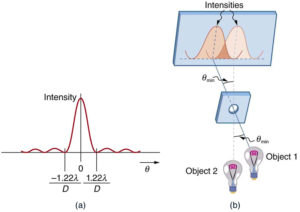Resolution Limit
Objectives
- Measure the resolution limit of your eye
- Calculate the average diameter of your pupil from your eye’s resolution limit
Resources
- Optical bench
- Diode laser
- Mounted diffraction patterns
- Optical screen
- Ruler and/or meter stick
Background
When light passes through a small circular aperture, it produces a spot with a fuzzy edge surrounded by circles of light, similar to that produced by a single slit. Light from different parts of the circular aperture interferes constructively and destructively. The effect is most noticeable when the aperture is small, but the effect is there for large apertures, too.
If two objects are viewed through an opening of diameter D, they will not be distinguishable as separate objects if their diffraction patterns overlap. Therefore, for a given wavelength of light \lambda, the smallest angular separation between objects that can still be resolved (i.e. the angular resolution) is \theta=1.22\frac{\lambda}{D}
Setup
Mount the laser, diffraction mask, and screen on the optical bench as shown above. Adjust the slit mask so that the laser falls on a pattern that produces many closely-spaced dots on the screen. The hexagon pattern shown above is ideal, but a single- or double-slit pattern that produces many closely spaced spots will work as well.
Move the diffraction mask as close to the optical screen as you can while still be able to see separate dots in the interference pattern from close up (10-25cm). Determine the distance between dots in the pattern by measuring or using some other method. Back up until just at the point you can no longer distinguish the dots in the pattern separately with your eyes. Measure the distance to the screen and calculate the angular resolution of your eyes. Use this to calculate the diameter of your pupils.
Analysis Questions
- What is the uncertainty in your pupil diameter calculation, based on your measurements?
- How does your pupil change in bright light? Does this increase or decrease your eyes’ angular resolution?
- What is the average range of diameters for the pupil of a human eye?
